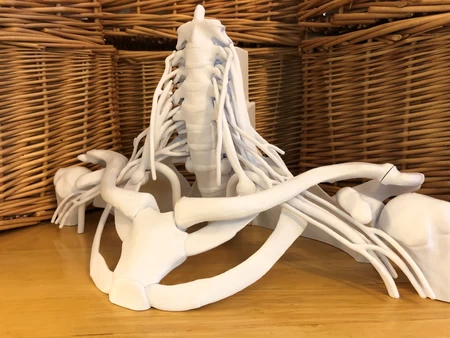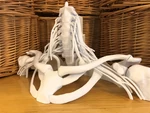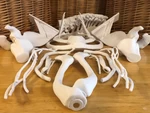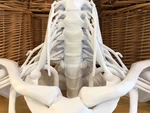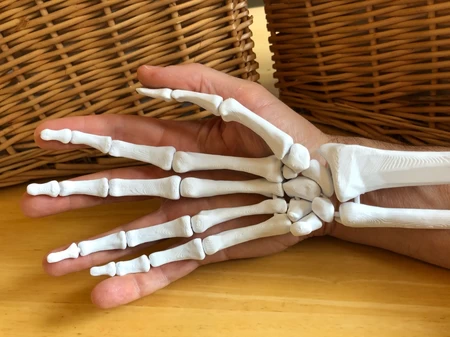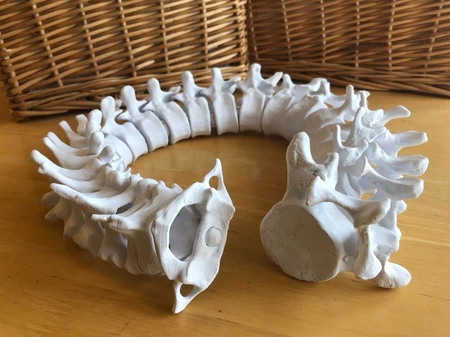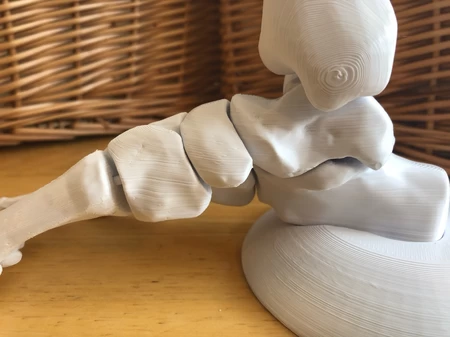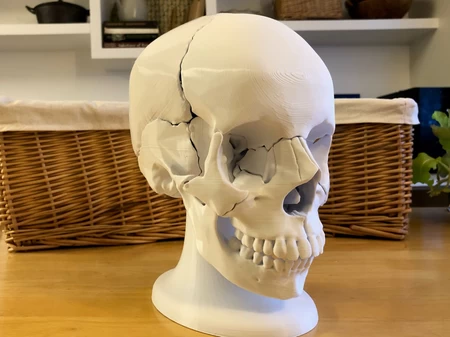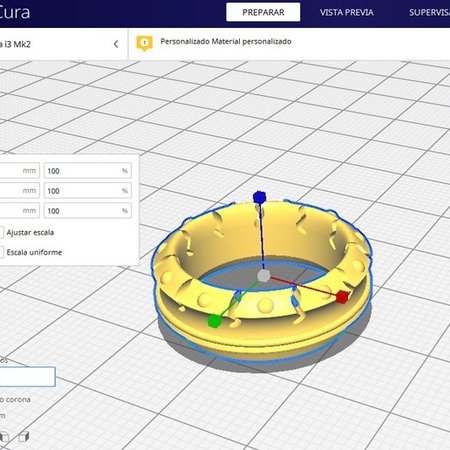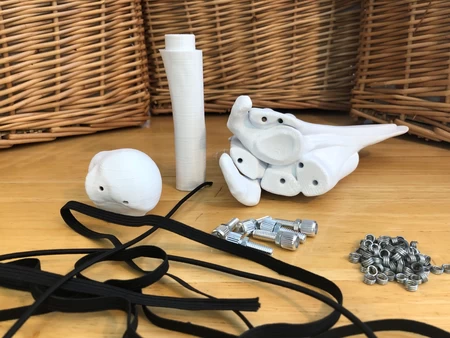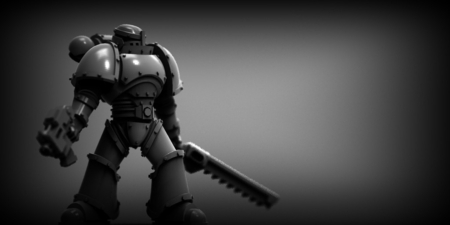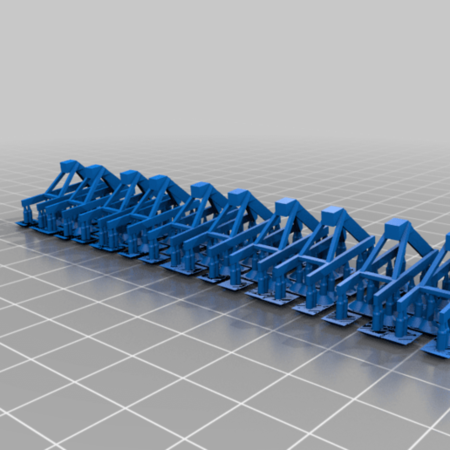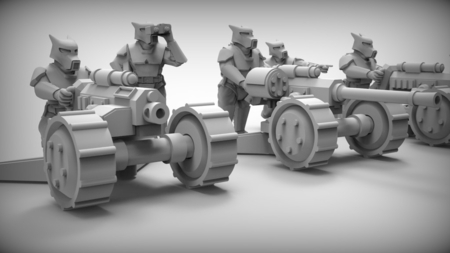16 件全尺寸臂丛神经模型 3D打印
5879 视图 5 喜欢 0 下载 下载
点击此处观看视频...:https://youtu.be/Uol33HA0QOc
点击此处下载稳定版本:https://thangs.com/mythangs/file/47926
臂丛是肩部的神经网络,它将运动和感觉信号从脊髓传递到手臂和手部。该模型旨在用作临床教育工具,特别是用于超声引导的神经阻滞和手术麻醉。
该模型可以直立或仰卧使用。您可以打印单侧或双侧肩膀。使用不同颜色的细丝来强调结构。
“臂丛”包括所有根部、躯干、分支、索和分支,以及肩胛上神经和长胸神经的近端部分。膈神经也包括在内,这并不是因为它是臂丛的一部分,而是因为它是在该区域进行神经阻滞或手术时需要识别和避免的结构。
主要结构件用磁铁固定。要用磁铁组装两侧,您需要 36 1/4” x 1/8” (6mm x 3mm) 圆柱形钕磁铁。www.kjmagnetics.com 是磁铁的良好来源。可以将零件粘在一起以进行永久连接。
臂丛和膈神经的根部通过椎间孔中的插入孔连接。臂丛和锁骨下/腋动脉也由锁骨固定。
以下部件构成结构基础:
• 脊柱基础
• 右和/或左肩胛骨菱形基础
• 胸骨肋骨基础
• 右和/或左锁骨
以下部件是非结构性的。打印您需要的部件和侧面:
• 肱骨头
• 前斜角肌
• 臂丛
• 膈神经
• 锁骨下/腋动脉
这是高级打印,需要具备设置支撑和打印后清理方面的知识。
“脊柱基础”和“肩胛骨菱形基础”应按提供的方式打印。其余文件处于“建议方向”,您可能需要根据您的喜好、设备和技能水平重新调整和准备它们。通常,请尝试将外表面向上定位,以便与支撑结构接触的表面在最终模型中不太明显。
对于底部表面轮廓分明且支撑区域难以触及的部件,请尝试将模型抬高几毫米,使其远离构建板并使用“树形支撑”。
以下是组装注意事项:
• 在插入磁铁之前,使用 1/4 英寸钻头清理磁铁锚以消除任何瑕疵,使磁铁正确就位。
• 确保插入磁铁时极性正确,以便正确连接。
• 您可能需要使用胶水将一些磁铁固定到位,尤其是使用较小的公制尺寸时。 CA 胶效果很好。
• 预计使用砂纸和锉刀进行一些打印后清理。
已尽一切努力保持解剖正确性;但是,需要进行以下小修改以优化 3D 打印文件:
• 已添加磁铁锚以允许插入磁铁。
• 某些区域的骨骼已加厚,以支撑磁锚并增加强度
• 肩胛骨后脊的一部分已扩大,以支撑仰卧模型。
• 所有神经结构都已加厚,以增加强度并方便打印。
• 臂丛神经在某些区域已重塑,以方便打印和组装。 这些改变在正常的解剖变异范围内。
• 前斜角肌的位置略微靠前,以在斜角肌间三角中创造更多空间。
• 在第一肋骨上添加了凹槽,以便正确定位锁骨下动脉。
该项目是与 Eric Kramer 及其同事合作完成的。
Eric Kramer 是一名护士麻醉师和执业护士,对护理点超声和超声引导局部麻醉感兴趣。他是国立大学博士护士麻醉学项目的教师,也是开放源医学 (learn.osmedicine.org) 的创始人,这是一个致力于培训发展中国家国家麻醉师的非营利组织。
该项目使用 BodyParts3D 的参考文件,© 生命科学数据库中心,根据 CC 署名-相同方式共享 2.1 日本许可
设计师
DaveMakesStuff3D 模型描述
这个由 16 块材料制成的全尺寸解剖模型显示了臂丛神经相对于周围骨骼、肌肉和动脉的位置。点击此处观看视频...:https://youtu.be/Uol33HA0QOc
点击此处下载稳定版本:https://thangs.com/mythangs/file/47926
臂丛是肩部的神经网络,它将运动和感觉信号从脊髓传递到手臂和手部。该模型旨在用作临床教育工具,特别是用于超声引导的神经阻滞和手术麻醉。
该模型可以直立或仰卧使用。您可以打印单侧或双侧肩膀。使用不同颜色的细丝来强调结构。
“臂丛”包括所有根部、躯干、分支、索和分支,以及肩胛上神经和长胸神经的近端部分。膈神经也包括在内,这并不是因为它是臂丛的一部分,而是因为它是在该区域进行神经阻滞或手术时需要识别和避免的结构。
主要结构件用磁铁固定。要用磁铁组装两侧,您需要 36 1/4” x 1/8” (6mm x 3mm) 圆柱形钕磁铁。www.kjmagnetics.com 是磁铁的良好来源。可以将零件粘在一起以进行永久连接。
臂丛和膈神经的根部通过椎间孔中的插入孔连接。臂丛和锁骨下/腋动脉也由锁骨固定。
以下部件构成结构基础:
• 脊柱基础
• 右和/或左肩胛骨菱形基础
• 胸骨肋骨基础
• 右和/或左锁骨
以下部件是非结构性的。打印您需要的部件和侧面:
• 肱骨头
• 前斜角肌
• 臂丛
• 膈神经
• 锁骨下/腋动脉
这是高级打印,需要具备设置支撑和打印后清理方面的知识。
“脊柱基础”和“肩胛骨菱形基础”应按提供的方式打印。其余文件处于“建议方向”,您可能需要根据您的喜好、设备和技能水平重新调整和准备它们。通常,请尝试将外表面向上定位,以便与支撑结构接触的表面在最终模型中不太明显。
对于底部表面轮廓分明且支撑区域难以触及的部件,请尝试将模型抬高几毫米,使其远离构建板并使用“树形支撑”。
以下是组装注意事项:
• 在插入磁铁之前,使用 1/4 英寸钻头清理磁铁锚以消除任何瑕疵,使磁铁正确就位。
• 确保插入磁铁时极性正确,以便正确连接。
• 您可能需要使用胶水将一些磁铁固定到位,尤其是使用较小的公制尺寸时。 CA 胶效果很好。
• 预计使用砂纸和锉刀进行一些打印后清理。
已尽一切努力保持解剖正确性;但是,需要进行以下小修改以优化 3D 打印文件:
• 已添加磁铁锚以允许插入磁铁。
• 某些区域的骨骼已加厚,以支撑磁锚并增加强度
• 肩胛骨后脊的一部分已扩大,以支撑仰卧模型。
• 所有神经结构都已加厚,以增加强度并方便打印。
• 臂丛神经在某些区域已重塑,以方便打印和组装。 这些改变在正常的解剖变异范围内。
• 前斜角肌的位置略微靠前,以在斜角肌间三角中创造更多空间。
• 在第一肋骨上添加了凹槽,以便正确定位锁骨下动脉。
该项目是与 Eric Kramer 及其同事合作完成的。
Eric Kramer 是一名护士麻醉师和执业护士,对护理点超声和超声引导局部麻醉感兴趣。他是国立大学博士护士麻醉学项目的教师,也是开放源医学 (learn.osmedicine.org) 的创始人,这是一个致力于培训发展中国家国家麻醉师的非营利组织。
该项目使用 BodyParts3D 的参考文件,© 生命科学数据库中心,根据 CC 署名-相同方式共享 2.1 日本许可
